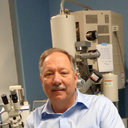Comparison of helper component-protease RNA silencing suppression activity, subcellular localization, and aggregation of three Korean isolates of Turnip mosaic virus.
Cuvinte cheie
Abstract
In 2014, we performed a nationwide survey in Korean radish fields to investigate the distribution and variability of Turnip mosaic virus (TuMV). Brassica rapa ssp. pekinensis sap-inoculated with three isolates of TuMV from infected radish tissue showed different symptom severities, whereas symptoms in Raphanus sativus were similar for each isolate. The helper component-protease (HC-Pro) genes of each isolate were sequenced, and phylogenetic analysis showed that the three Korean isolates were clustered into the basal-BR group. The HC-Pro proteins of these isolates were tested for their RNA silencing suppressor (VSR) activity and subcellular localization in Nicotiana benthamiana. A VSR assay by co-agroinfiltration of HC-Pro with soluble-modified GFP (smGFP) showed that HC-Pro of isolate R007 and R041 showed stronger VSR activity than R065. The HC-Pros showed 98.25 % amino acid identity, and weak VSR isolate (R065) has a single variant residue in the C-terminal domain associated with protease activity and self-interaction compared to isolates with strong VSR activity. Formation of large subcellular aggregates of GFP:HC-Pro fusion proteins in N. benthamiana was only observed for HC-Pro from isolates with strong VSR activity, suggesting that R065 'weak' HC-Pro may have diminished self-association; substitution of the variant C-terminal residue largely reversed the HC-Pro aggregation and silencing suppressor characteristics. The lack of correlation between VSR efficiency and induction of systemic necrosis (SN) suggests that differences in viral accumulation due to HC-Pro are not responsible for SN.


